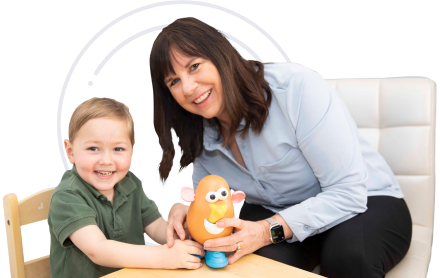Should Parents Be in the Therapy Room or Waiting Room?
Dr. Mary Barbera
When Lucas was two years old, before his diagnosis of autism, we took him to speech therapy sessions weekly at our local hospital and the speech therapist that worked with him was great. She really taught me a lot. I was allowed and encouraged to be in the therapy room. They also had an option to stand behind a two-way glass so if I had my younger son Spencer with me I would go behind the glass. If I was there by myself I would go right in the therapy room so that I could watch her work with Lucas.
Want to Learn how to Increase Talking & Decrease Tantrums in Children with Autism or Toddlers Showing Signs?
Want to start making a difference for your child or clients?

At the time I didn’t know anything about autism or the verbal operants. I didn’t know anything about how to teach Lucas language. So it was great that the speech pathologist worked with Lucas in front of me and then I was able to get to see some of the things that she was doing and learn more. Now, this was back in 1998 and some of the things she was doing like blowing bubbles or using toys with parts and pairing the words were great for Lucas, especially because he had some words, but I just didn’t know how to get those words to come out when I wanted them to come out.
She was able to get some words out during those fun activities. However, in some of the speech therapy sessions she was working on things like prepositions, some versus all and none, is this an apple, yes or no? These skills were way too hard for Lucas and I had no idea that they were too hard and obviously she didn’t either. It took us years later till Lucas was able to master those skills.
Back in the late ’90s, I asked her, “Where can I learn how to help him? I have multiple hours a day when I could be home doing things with him.” She really wasn’t able to direct me to any resources and that’s one of the reasons I’ve created three online courses now and wrote my book…..to help parents and professionals learn proven strategies to help kids increase language.
I recently had a question on a private Facebook Group from a parent of a toddler who, like me, took her son to speech therapy sessions. However, unlike me, where I had to only drive five minutes away to the local hospital, she had to drive 70 miles away to get to the speech therapy center. And the child’s speech therapist took the two-and-a-half-year-old back to her office and asked the parent to wait in the waiting room while she provided the speech therapy session.
Mom sat in the waiting room as directed, but she could hear her son crying the whole way into the therapy room and actually heard him crying through the door. This is really not what I recommend, which the parent knew from taking my online course. I recommend pairing/manding and making sure the child is happy. I kind of equate it to if I was learning to fly a plane and you were trying to teach me to fly a plane and I had no idea what I was doing and I am sobbing to the point where I am hyperventilating. How much do you think I’m going to really be paying attention and learning the different controls in the panel?
So a child should not be crying during therapy. Now sure, there are moments where a child cries and in the skilled hands of a behavior analyst who knows how to address the functions of behavior, we can sometimes turn it around so it doesn’t happen in the future. But a child should not be crying routinely during therapy. So this mom asked on the Facebook page if this was okay that to let the therapist take him back without her, and we all said no.
The parent needs to be with the child in the therapy room, especially if they’re not communicating. Also the parent really needs to be learning from the speech pathologist, making sure that the speech pathologist is pairing and manding and not working on things like prepositions and colors and things that are too hard for the child. Everybody needs to be on the same page.
If you are a professional I would really encourage you to not only tolerate parents in the room during your therapy sessions, but to encourage them to be in the therapy room to work with them so that the child can reach his or her fullest potential.
So I’m a big proponent of the parent in the therapy room as much as possible and not out in the waiting room. Thanks a lot for listening and I’ll see you next week.